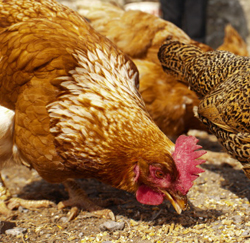Free range egg standards are set to drop dramatically in Queensland, the state which have long been reputed as a leader in the production of free range eggs in Australia.
The Queensland Government has significantly weakened its free range egg standards, raising the allowable stocking density from 1,500 birds per hectare to a massive 10,000 per hectare while outdoors.
The Queensland move comes at a time when the South Australian Government is adjusting its own voluntary free range standards to 1,500 birds per hectare in line with more humane free range accreditation systems, a move supported by Voiceless, the animal protection institute.
Prior to this amendment, Queensland farmers could only label their eggs free range if their birds were kept to a maximum stocking density of 1,500 hens per hectare when roaming outdoors. The amended regulations will allow producers to raise their flock to a whopping 10,000 birds in an outdoor area of the same size.
“This means that farmers can increase their stocking densities by over 660 per cent, while continuing to label their eggs free range,” says Voiceless Legal Counsel, Emmanuel Giuffre.
While the amendment has introduced modest improvements to conditions on free range farms including paddock rotation, eight hour outdoor access and shed opening requirements, Voiceless considers the increased stocking density is a significant step backward for the welfare of free range hens.
Among Voiceless’s chief concerns is that free range producers who had previously been following the maximum stocking density of 1,500 hens will now be incentivised to squeeze a far greater number of hens into their current free range system.
“It is reasonable to expect that producers will not want to incur the expense of increasing their shed capacities and may simply cram more hens into sheds to take advantage of the increased outdoor stocking densities,” says Giuffre.
“While the Model Code allows for higher densities in certain circumstances, a stocking density of 10,000 would be considered unreasonable under any free range system. A 10,000 hen stocking density is also significantly higher than other Australian free range accreditation schemes, and is largely out of step with hen welfare and consumer expectations.”
The Queensland Government said the 1,500 stocking density placed the industry at a disadvantage, since most free range stocking densities occur well above 1,500 birds per hectare. The Queensland Government also placed reliance on the Australian Egg Corporation Limited’s higher proposed industry standard for free range stocking densities, a standard rejected by the Australian Competition and Consumer Commission last year.
“This rationale is deeply concerning – largely because it puts the interests of industry and increased productivity well before hen welfare within the free range system. It is well documented that higher stocking densities directly impact on hen welfare and causes hens to become frustrated, resulting in violent anti-social behaviours such as pecking, bulling and cannibalism.”
The Queensland Government’s amendments are clearly at odds with consumer expectations, and will only serve to further confuse consumers as to what the term ‘free range’ actually means.
“Queensland has long been reputed as a leader in the production of free range eggs in Australia. As consumers have not been appropriately informed of this change, many will continue to purchase Queensland free range eggs on the assumption that those eggs were produced in accordance with the old standards,” says Giuffre.
Greens Animal Welfare and Consumer Affairs spokesperson, Tammy Franks, labelled the move “a backwards step for animal welfare”.
According to South Australia’s Minister for Business and Consumer Services, John Rau, the Queensland Government’s relaxing of the rules on free-range laying hens is disappointing.
Choice has also weighed in on the debate.

